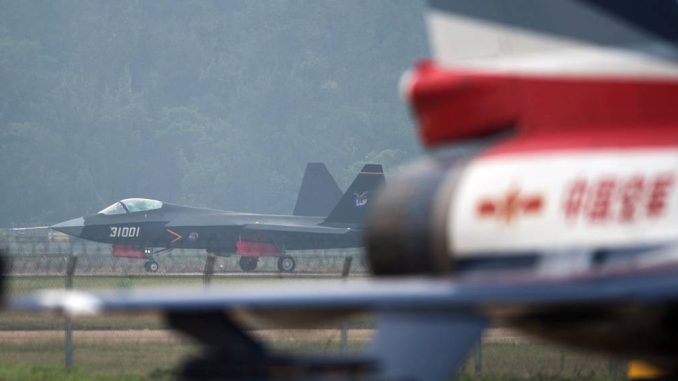

MELBOURNE, Australia – China will debut its next-generation, carrier-borne fighter jet later this year, according to the country’s main state-owned aerospace conglomerate and the chief designer of its current carrier-based fighter jet.
This comes as China has demonstrated a pair of its land-based J-20 stealth fighters powered by indigenous engines at the ongoing Zhuhai airshow.
Speaking at a press conference at the airshow, Sun Cong, the chief designer of the mainstay jet fighter of China’s People’s Liberation Army Navy, or PLAN, carrier air wings, said that “people should be able to see good news on the next-generation aircraft carrier-based fighter jet” later this year.
Sun led the design of the Shenyang J-15 Flying Shark. He said more will be revealed about the new program when the time is right, according to remarks carried by the nationalist tabloid Global Times.
Similarly, state-owned aerospace and defense conglomerate Aviation Industry Corporation of China, or AVIC, said on its account on Chinese social media app Weibo that a new carrier-borne aircraft would be revealed before the end of 2021, although it is not clear if it was making its own announcement or just echoing Sun’s remarks.
Neither Sun nor AVIC revealed more details about the program, although the social media post included a graphic showing what appeared to be a stealthy twin-tailed design under wraps.
It has been speculated in recent years that China is developing a new carrier-based fighter jet based on the Shenyang J-31 as the next-generation combat aircraft to equip China’s growing fleet of aircraft carriers.
China has two carriers in service and is building a third, significantly larger carrier. The first two ships are equipped with a ski-jump to assist aircraft in taking off, while the latest vessel being constructed in Shanghai will be equipped with catapults to launch heavier aircraft and conduct operations more quickly.
The J-31 is a twin-tailed, twin-engine, mid-wing design that incorporates some low-observable features and bears a passing resemblance to the Lockheed-Martin F-35 Lightning II Joint Strike Fighter. It first flew in October 2012 and was present at the 2014 Zhuhai airshow.
Originally a private venture designed for the export market, the type found no takers among the group of countries that sought Chinese arms, however the design underwent a substantial rework and started flying again in 2016.
Like the J-15, the J-31 has so far only flown with imported Russian engines, although China has since made strides in its ongoing efforts to refine its own indigenous combat aircraft engine development efforts.
This is underscored by the stealthy Chengdu J-20 fighter powered by indigenous engines making its debut at this year’s Zhuhai airshow, with a pair of aircraft powered by WS-10C engines taking part in the daily flying display.
Both jets carried People’s Liberation Army Air Force, or PLAAF, national insignia, although neither carried five-digit PLAAF serial numbers.
These aircraft will join the increasing number of twin-engined Shenyang J-11s and J-16s, powered by the indigenous WS-10 since around 2011 or 2012. The single-engine Chengdu J-10, powered by the WS-10, has also started entering service with PLAAF units, replacing the Russian AL-31 turbofan engine after a protracted development cycle.
However, production examples of the carrier-borne J-15, which like the J-11 and J-16 have roots in the Russian Sukhoi Su-27/30 Flanker family of multirole fighter jets, continue to be powered by the Russian engine.



Be the first to comment